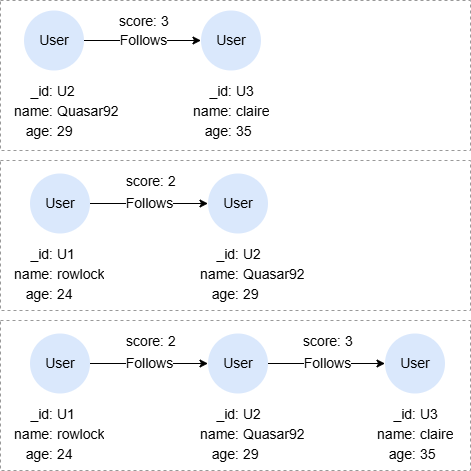Overview
A quantified path is a variable-length path where the complete path or a part of it is repeated a specified number of times.
Quantified paths are useful when you:
- Don’t know the exact number of hops required between nodes.
- Need to capture relationships at varying depths.
- Want to simplify queries by compressing repetitive pattens.
Quantifiers
A quantifier is written as a postfix to either an edge pattern or a parenthesized path pattern to specify how many times the pattern should repeat.
Quantifier |
Description |
|---|---|
{m,n} |
Between m and n repetitions. |
{m} |
Exactly m repetitions. |
{m,} |
m or more repetitions. |
{,n} |
Between 0 and n repetitions. |
* |
Between 0 and more repetitions. |
+ |
Between 1 and more repetitions. |
Example Graph

CREATE GRAPH myGraph {
NODE User ({name string}),
NODE Device (),
EDGE Owns ()-[{}]->(),
EDGE Flows ()-[{packets int32}]->()
} PARTITION BY HASH(Crc32) SHARDS [1]
INSERT (jack:User {_id: "U01", name: "Jack"}),
(mike:User {_id: "U02", name: "Mike"}),
(c1:Device {_id: "Comp1"}),
(c2:Device {_id: "Comp2"}),
(c3:Device {_id: "Comp3"}),
(c4:Device {_id: "Comp4"}),
(jack)-[:Owns]->(c1),
(mike)-[:Owns]->(c4),
(c1)-[:Flows {packets: 20}]->(c2),
(c1)-[:Flows {packets: 30}]->(c4),
(c2)-[:Flows {packets: 34}]->(c3),
(c2)-[:Flows {packets: 12}]->(c4),
(c3)-[:Flows {packets: 74}]->(c4)
Building Quantified Paths
When writing a quantified path to its full form:
- Two consecutive node patterns are merged into a single node pattern with their filtering conditions combined using logical
AND. - Two consecutive edge patterns are implicitly connected by an empty node pattern.
Quantified Edge
Edge patterns can be directly followed by a quantifier, and both the full and abbreviated edge patterns are supported.
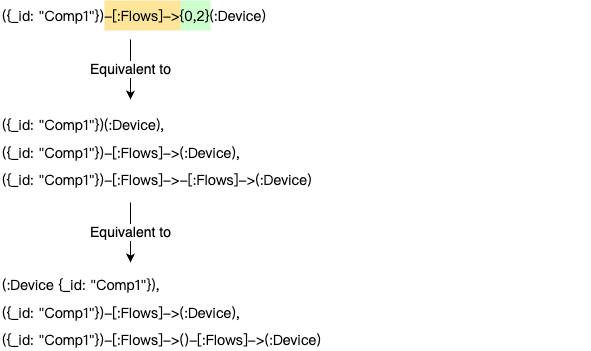
Quantified Entire Path
You can enclose the entire path pattern in parentheses () and append a quantifier.
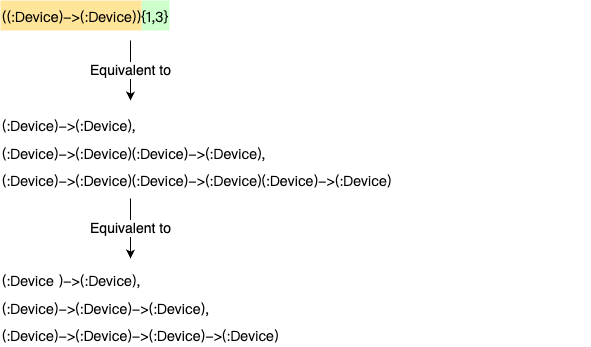
When a quantifier is applied to an entire path pattern, a step count of 0 produces no result.
Quantified Partial Path
You can enclose part of a path pattern in parentheses () and append a quantifier for it.
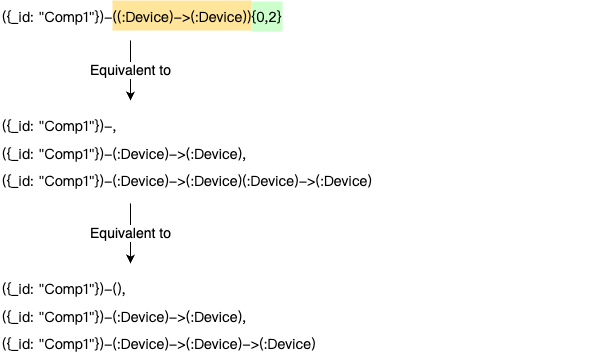
Another example:

Examples
Lowerbound and Upperbound
MATCH p = ({name: 'Jack'})->()-[f:Flows WHERE f.packets > 15]->{1,3}()<-({name: 'Mike'})
RETURN p
Result: p
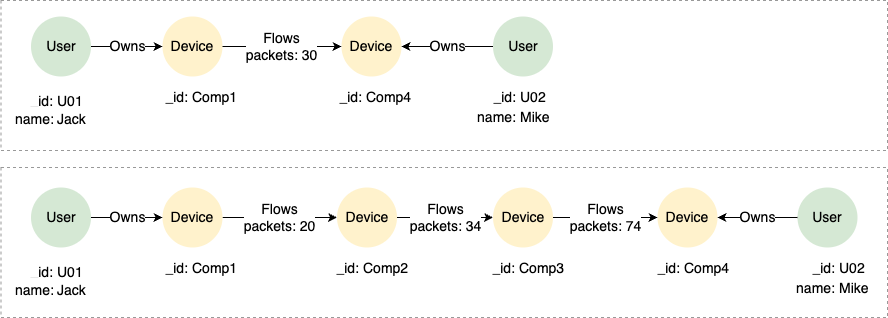
Fixed Length
MATCH p = ((:Device)->(:Device)){2}
RETURN p
Result: p
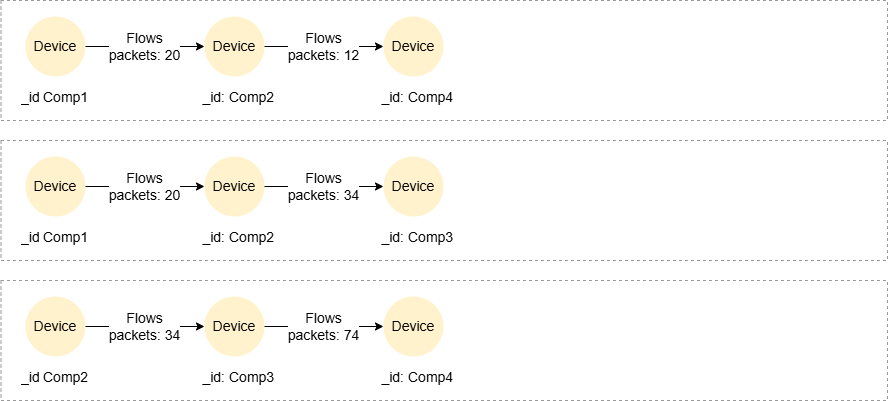
Fixed Lowerbound
MATCH ({_id: 'Comp1'})->{2,}(n)
RETURN COLLECT_LIST(n._id)
Result:
| COLLECT_LIST(n._id) |
|---|
| ["Comp4","Comp3","Comp4"] |
MATCH p = ({_id: 'Comp1'})-[f:Flows WHERE f.packets > 20]->*()
RETURN p
Result: p

MATCH p = ({_id: 'Comp1'})-[f:Flows WHERE f.packets > 20]->+()
RETURN p
Result: p

Fixed Upperbound
MATCH p = ({name: 'Jack'})->(()-[f:Flows WHERE f.packets > 15]->()){,2}<-({name: 'Mike'})
RETURN p
Result: p

Group Variables
Element variables declared within the repeatable part of a quantified path are bound to a list of nodes or edges, known as group variables or group list.
Example Graph

CREATE GRAPH myGraph {
NODE User ({name string, age uint32}),
EDGE Follows ()-[{score uint32}]->()
} PARTITION BY HASH(Crc32) SHARDS [1]
INSERT (rowlock:User {_id: "U1", name: "rowlock", age: 24}),
(quasar92:User {_id: "U2", name: "Quasar92", age: 29}),
(claire:User {_id: "U3", name: "claire", age: 35}),
(rowlock)-[:Follows {score: 2}]->(quasar92),
(quasar92)-[:Follows {score: 3}]->(claire)
Referencing Outside the Quantified Segment
Whenever a group variable is referenced outside the repeatable part of the quantified path where it is declared, it refers to a list of nodes or edges.
In this query, variables a and b represent lists of nodes encountered along the matched paths, rather than individual nodes:
MATCH p = ((a)-[]->(b)){1,2}
RETURN p, a, b
Result:
| p | a | b |
|---|---|---|
 |
[(:User {_id:"U2", name:"Quasar92", age:29})] | [(:User {_id:"U3", name:"claire", age:35})] |
 |
[(:User {_id:"U1", name:"rowlock", age:24})] | [(:User {_id:"U2", name:"Quasar92", age:29})] |
 |
[(:User {_id:"U1", name:"rowlock", age:24}), (:User {_id:"U2", name:"Quasar92", age:29})] | [(:User {_id:"U2", name:"Quasar92", age:29}), (:User {_id:"U3", name:"claire", age:35})] |
To aggregate the group variables, use the FOR statement to expand it into individual records:
MATCH path = ()-[edges]->{1,2}()
CALL (path, edges) {
FOR edge IN edges
RETURN sum(edge.score) AS scores
}
FILTER scores > 2
RETURN path, scores
Result:
| p | scores |
|---|---|
 |
3 |
 |
5 |
The following query throws syntax error since a and b are lists:
MATCH p = ((a)-[]->(b)){1,2}
WHERE a.age < b.age
RETURN p
Referencing Inside the Quantified Segment
A group variable has a singleton reference only when it is referenced within the repeatable part of the quantified path where it is declared.
In this query, a and b are treated as singletons that represent individual nodes. The condition a.age < b.age is evaluated for each pair of nodes a and b as the path is matched:
MATCH p = ((a)-[]->(b) WHERE a.age < b.age){1,2}
RETURN p
Result: p
